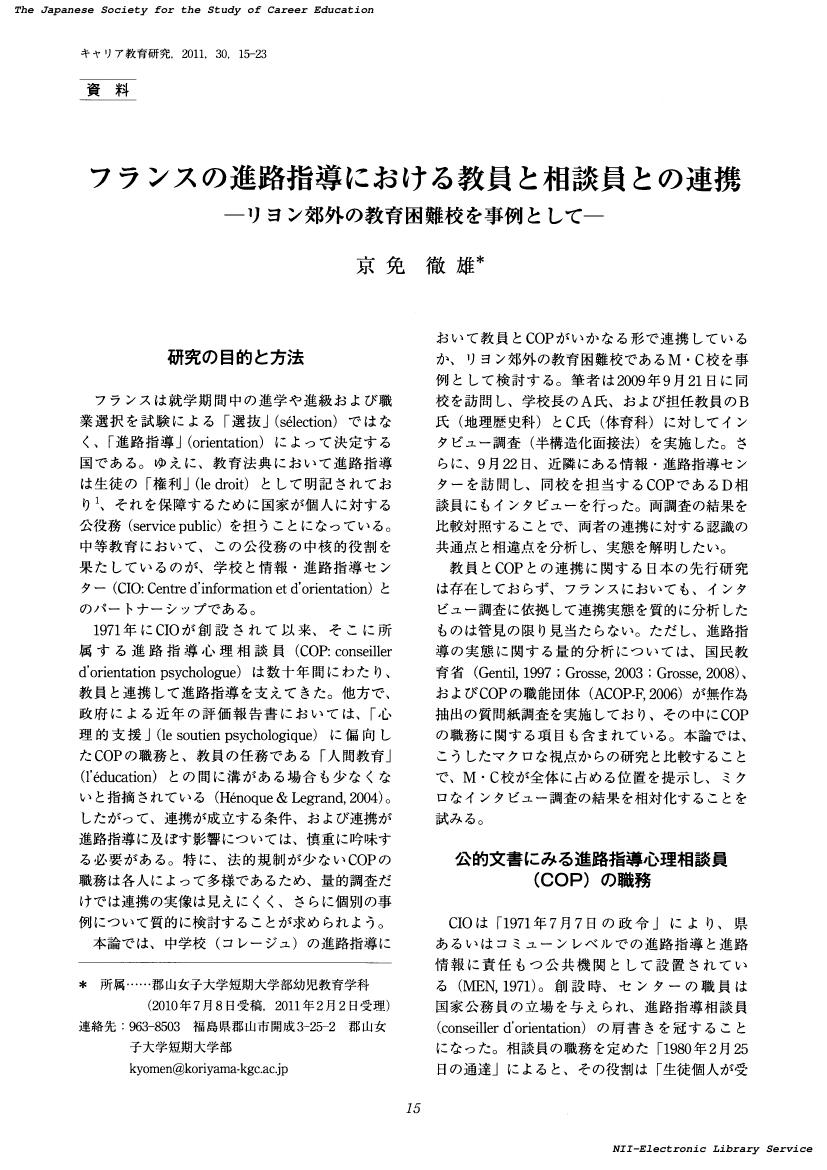- 著者
- 知念 秀明 中尾 達馬
- 出版者
- 日本キャリア教育学会
- 雑誌
- キャリア教育研究 (ISSN:18813755)
- 巻号頁・発行日
- vol.37, no.1, pp.11-16, 2018
1 0 0 0 OA 学生生活の意味深さと職業観およびキャリア意識との関連―人文系初年次学生を対象として―
- 著者
- 古田 克利
- 出版者
- 日本キャリア教育学会
- 雑誌
- キャリア教育研究 (ISSN:18813755)
- 巻号頁・発行日
- vol.37, no.1, pp.1-10, 2018-09-30 (Released:2018-09-30)
- 参考文献数
- 36
This study aims to measure the Meaningfulness of University Life and to clarify its features, and to consider the relations between the Meaningfulness of University Life and Work Value and Career Consciousness. Firstly, I measured the Meaningfulness of University Life based on a scale measure of calling, whose definition was clarified by Dobrow & Tosti-Kharas (2011). In this study, with reference to the scale measure of calling, I created a 9-item scale measure of Meaningfulness to measure the 3 aspects of studying, extracurricular activities (various kinds of clubs) and part-time jobs. After comparing the average of Meaningfulness of the 3 aspects, one aspect which is a meaning of University Life (studying) is significantly lower than the other 2 aspects. Secondly, I clarify the relation between the Meaningfulness of University Life, Work Value and the Career Action Vision Test (CAVT). As a result of this analysis, the Meaningfulness of studying showed a significant correlation with Work Value and CAVT.
1 0 0 0 OA フランスの進路指導における教員と相談員との連携 : リヨン郊外の教育困難校を事例として
- 著者
- 京免 徹雄
- 出版者
- 日本キャリア教育学会
- 雑誌
- キャリア教育研究 (ISSN:18813755)
- 巻号頁・発行日
- vol.30, no.1, pp.15-23, 2011-09-30 (Released:2017-06-24)
- 著者
- 田澤 実 梅崎 修
- 出版者
- 日本キャリア教育学会
- 雑誌
- キャリア教育研究 (ISSN:18813755)
- 巻号頁・発行日
- vol.35, no.1, pp.21-27, 2016
1 0 0 0 サッカークラブ指導者の職業化の実態と展望
- 著者
- 前田 博子 山口 泰雄 竹下 俊一 加藤 寛 石川 慎之助
- 出版者
- 日本キャリア教育学会
- 雑誌
- キャリア教育研究 (ISSN:18813755)
- 巻号頁・発行日
- vol.34, no.2, pp.41-52, 2016-03-31
The purpose of this study is to discuss issues related to the careers of football club coaches. Specifically, it clarifies the current state of the professionalization of the coaches and future prospects for the professionalization of young volunteer coaches (YVs), and examines their factors. Furthermore, it examines appropriate support measures based on the results obtained. Research methods included data collection by questionnaires targeting football clubs and statistical method data analysis. First, descriptive statistics for the entire data and crosstabs between items were used for analysis. Descriptive statistics, crosstabs and one-way ANOVA were used for items related to YVs. Currently, 26.6% of coaches are full-time, and 25.7% are other paid workers. YVs (25 years old or younger; do not maintain a living by coaching) comprised 15.8% of the total, and represented in the 51.8% of the clubs. Of these clubs, 67% predicted YVs would remain volunteers in the future. The degree of professionalization of the coaches varied depending on scale of the club, type of legal entity, and degree of policy modeling. The study concludes that in order to solve problems related to the careers of local sports club coaches, complex measures suited to the situation surrounding the club and coach must be taken. In response, the following 3 countermeasures are proposed: to proceed with club type-specific measures to professionalize coaches, to promote development of programs linked to career acquisition for young volunteer coaches, and to advance measures to promote civil organizations and companies that support volunteer coaches.
- 著者
- 若松 養亮
- 出版者
- 日本キャリア教育学会
- 雑誌
- キャリア教育研究 (ISSN:18813755)
- 巻号頁・発行日
- vol.32, no.1, pp.21-29, 2013
1 0 0 0 大学生における「学業に対するリアリティショック」尺度の作成
- 著者
- 半澤 礼之
- 出版者
- 日本キャリア教育学会
- 雑誌
- キャリア教育研究 (ISSN:18813755)
- 巻号頁・発行日
- vol.25, no.1, pp.15-24, 2007-06-30
- 被引用文献数
- 1
1 0 0 0 小学生の希望職業からみた職業的発達の検討
- 著者
- 宮田 延実
- 出版者
- 日本キャリア教育学会
- 雑誌
- キャリア教育研究 (ISSN:18813755)
- 巻号頁・発行日
- vol.30, no.2, pp.53-60, 2012
1 0 0 0 大学進学理由と大学での学習観の測定 : 尺度の構成を中心として
- 著者
- 三保 紀裕 清水 和秋
- 出版者
- 日本キャリア教育学会
- 雑誌
- キャリア教育研究 (ISSN:18813755)
- 巻号頁・発行日
- vol.29, no.2, pp.43-55, 2011-03-31
The conceptual frameworks to measure the university entrance reasons and the conceptions of learning in university were examined. Reviewing the published researches in these fields, the questionnaire that consisted of 48 items for the university entrance reasons and 44 items for the conceptions of learning in university was constructed according to the two dimensional frameworks. The participants were 725 freshmen enrolled in a private university. Exploratory factor analysis for the university entrance reasons revealed following four factors; study orientation, extracurricular activities, examination ranking for university, and evaluation of neighborhood. For the conceptions of learning in university, exploratory factor analysis was also conducted. The following four factors were extracted; active learning, development, acquisitive attitude for credits, and passive. The high reliability eight sub-scales were constructed from the factor pattern matrices of these factor analyses. The validities of these sub-scales were examined on the relationships among these sub-scales using canonical correlation analysis and the mean differences between entrance examination group and interview examination group by ANOVA. Finding of these analyses were discussed with particular reference to the issues of transition from high-school to university.
- 著者
- 藤岡 秀樹
- 出版者
- 日本キャリア教育学会
- 雑誌
- キャリア教育研究 (ISSN:18813755)
- 巻号頁・発行日
- vol.28, no.2, pp.67-70, 2010-03-31
